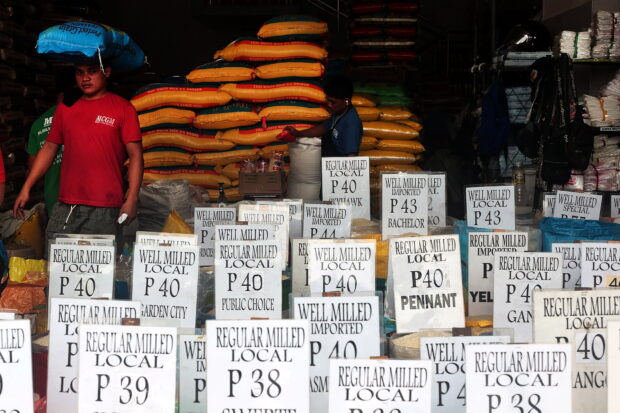Neda: Boost rice buffer before start of El Niño

NO SIGN OF SHORTAGE Regular and well-milled rice sold at a
store in Cubao, Quezon City, last week. —GRIG C. MONTEGRANDE
MANILA, Philippines — The National Economic and Development Authority (Neda) warns that the El Niño phenomenon, which is characterized by prolonged dry weather, is expected to develop as early as next month and threaten the country’s food production, especially of rice.
It suggested that the government immediately prepare buffer stocks of milled rice ahead of the worsening of the dry spell and called for “prepositioning” supplies of the staple grain to ensure availability in supply-short provinces and at the same time address high food inflation in the country.
This was among the measures presented at the first-ever meeting on April 20 of secretaries—instead of assigned delegates—of the Inter-Agency Committee on Inflation and Market Outlook (IAC-IMO), which President Marcos ordered created last March 7 as a proactive measure to fight persistently high inflation.
Cochaired by Neda and the Department of Finance, the committee serves as an advisory body to the administration’s Economic Development Group on measures that will keep inflation, particularly on food and energy, within the government’s target range.
The Department of Budget and Management serves as vice chair of the committee while the members include the Department of Agriculture (DA), Department of Energy, Department of Science and Technology, and Department Trade and Industry.
The government weather agency Philippine Atmospheric, Geophysical and Astronomical Services Administration (Pagasa) had projected that El Niño would persist until 2024.
The DA already reactivated its El Niño task force earlier this month to mitigate the impact of the expected dry weather on crops, as DA deputy spokesperson Rex Estoperez noted that “when there is a calamity, whether it’s El Niño or typhoons, the biggest hit is always… agriculture.”
He said the task force is led by a steering committee of undersecretaries and assistant secretaries and assisted by a technical working group of representatives from the various DA agencies.
The DA said the mitigation and adaptation plan for this year would focus on building more water-related infrastructure, such as the development or rehabilitation of irrigation canals, diversion dams, and small-scale irrigation projects before the start of the El Niño.
Citing Pagasa’s forecast of rainfall, the DA said 16 provinces in Calabarzon (Cavite, Laguna, Batangas, Rizal, Quezon), Central and Eastern Visayas, Zamboanga Peninsula and Caraga Administrative Region (Agusan and Surigao provinces) would be affected by the El Niño.
Shortfall
In a meeting with the National Food Authority (NFA) and agriculture officials in Malacañang on April 13, Marcos noted that the government’s rice supply was “too low” and the government would have to boost its buffer stock through a combination of purchases from local producers and imports.
Press Secretary Cheloy Velicaria-Garafil said after the meeting that the NFA had been proposing the importation of 330,000 metric tons of rice to cover an “expected deficit” in the country’s buffer stock, especially for relief operations if calamities strike this year.
Given the NFA’s “budgetary constraints,” its buffer stock would fall to less than 500,000 sacks by July 2023, which would be equivalent to less than a day of public consumption, she said.
“We will make plans whether we need to import, whether we need to extend, whether we need to increase the NFA buffer stock because it is already too low,” said the President, who also sits as concurrent agriculture secretary.
Last week, lawmakers backed the President’s decision to boost the rice stock of the NFA through a mix of domestic purchases and imports as the agency has projected that the country’s rice inventory would decline to 45 days’ worth of consumption by the end of the year, or below its mandate to keep a buffer good for at least 90 days.
But Albay Rep. Joey Salceda, chair of the House ways and means committee, said he hoped the government would limit its imports to the lean months of July and August.
Ang Probinsyano party-list Rep. Alfred delos Santos pushed for the sourcing of the NFA’s buffer stock “primarily and directly from local rice farmers and cooperatives.”
Peasant groups have opposed the NFA’s proposed importation, saying the agency should instead buy more rice from local farmers.
Jayson Cainglet, executive director of Samahang Industriya ng Agrikultura (Sinag), said importation at this point was unnecessary since existing stocks were sufficient to tide the country until August.
Cathy Estavillo, secretary general of Amihan National Federation of Peasant Women and spokesperson for Bantay Bigas, said it was the NFA’s mandate to directly buy from local farmers since it is the harvest season, to ensure that it would have a sufficient buffer stock.
Mitigating measures
In a bid to address high food prices, Neda has also pushed for the improvement and expansion of the Kadiwa program to directly connect producers and consumers as well as the fast-tracking of the distribution of targeted subsidies to farmers and fisherfolk.
Based on a report from Neda, presented by Undersecretary Rosemarie Edillon during the IAC-IMO meeting, short-term measures to manage food inflation would also include filling the domestic supply gap through timely and adequate importation based on forecasts of supply and demand.
Another measure is the strengthening of the implementation of biosecurity and hog repopulation programs, referring to the Integrated National Swine Production Initiatives for Recovery and Expansion (Inspire) program and the BABay African swine fever (ASF).
According to the United Nations, high food prices remain a problem despite global prices having gone down to levels seen before the shocks from the Russian invasion of Ukraine which started in February 2022.
The Food and Agriculture Organization’s Food Price Index — the benchmark of international food commodity prices — declined for the 12th consecutive month in March, mainly due to easing prices of cereals and vegetable oils.